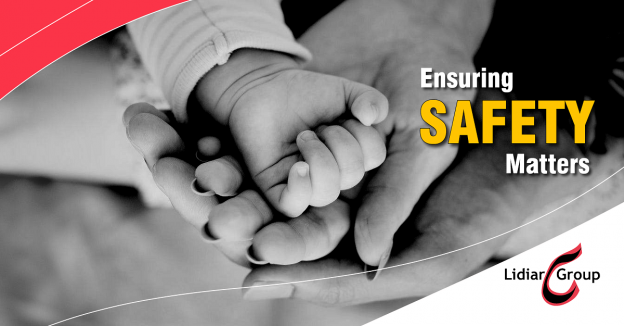
The Importance of Ensuring Safety Matters
By Georgina Poole
Nobody should fail to return home from work. But sadly in FY20/21 194 people lost their lives in workplace accidents.
194 people who went to work and never returned home. 194 mothers, fathers, sons, daughters, husbands, wives, friends and loved ones who started their work day as any other and rather than another day in their lives, it ended up being their last. And this statistic only covers fatalities – other workplace injuries occur at a mind boggling frequency that is simply unacceptable.
Simply put, that is why safety matters. It is why it should matter to everyone. It is why safety is at the top of the construction and infrastructure industry’s agenda. Sadly the things we can be passionate about and believe to be vital can become something we are complacent about because familiarity can lead to unconscious complacency.
So, how do we ensure that safety remains an active part of our agenda? How can we make sure we actively participate and don’t see safety as something that we are all aware of, but don’t really turn our minds to?
I think that the answer is organisation wide, active engagement.
Why safety cannot be tick boxes and checklists
There has been some confusion between safety work and safety of work:
- Safety work is activities like conducting inspections, observation checklists and putting up posters for various things – these types of activities add no value or impact to the front-line employees actually doing the work itself.
- Safety of work is conducting those activities that do add value – closing the gap between corporate strategy and the work being undertaken by the employees from the ground level up. Activities like facilitating learning teams that assist in identifying gaps in organisational systems and processes, reducing the compromise of safety and minimising the risk of injury and harm.
The former does nothing to create the latter. A poster in the office kitchen may offer a reminder, but it cannot prevent someone undertaking an unsafe lift, failing to identify an obvious hazard or simply switching off while undertaking their activities.
Therefore injuries, incidents and fatalities continue to occur because we continue to tick boxes. Poster placed? Job done. Annual safety week morning tea? Job done. The harsh reality is the opposite, they are part of safety, but are far from the entirety, and that’s what must change.
Safety must be culturally embedded in a workplace
A workplace’s health and safety culture impacts almost every aspect of the business – obviously, when there is a safety culture that is psychologically safe, workers trust their team members and their leaders to act accordingly when a health and safety issue is raised. This creates a happier, more productive workplace and allows creativity, innovation and continuous improvement.
Organisations with poor workplace culture become less attractive to prospective employees – In my own past personal experiences, prior to joining an organisation, I have reached out to numerous people within the company and asked them a couple of questions about the company’s health and safety culture. I have then used this information to assist me in determining if that workplace is somewhere I want to be. Hiring Managers and Recruiters tend to brush over this lightly in an interview. However, I find talking to real workers on the ground within that organisation gives a more realistic and telling view of what is going on.
From a contractual and commercial standpoint – no one wants to nor will award a tender to an organisation injuring workers by the busload. High injury rates or high event rates demonstrate there may be one or more major health and safety issues within that organisation. This impacts production and resources, however, also travels up the chain to be thought of from a liability perspective at the board level. Whether this kind of view is correct and appropriate in this day and age is a story for another time.
How safety can be embedded into an organisation
Ensure your employees understand their health and safety roles and responsibilities – this can be done via development/ training sessions, learning teams, and fun practical exercises. Training does not have to be boring or dull. Training can also help increase knowledge and understanding of health and safety in general – which is required if people are to be more accepting of change.
Organisations need to understand that embedding a positive health and safety culture does not just happen overnight, it takes time and requires all leaders at all levels of the organisation, from the bottom to the CEO and Board Members, to completely believe in and support the change.
Communication is key to embedding change, and by communication, I am referring to consultation. Your people are not the problem – they are the solution. Embrace them – their knowledge, expertise and opinions, regardless of how different they are, as their knowledge and understanding will take your organisation further than before on a path to positive safety.
This includes providing employees with the opportunity to give open and honest feedback on health and safety matters, processes, and systems. So listen to what they are telling you, negotiate if you need to and take on board what is being said. Your team undertake to act upon insights that have value and can make a difference.
When workers have felt like they were listened to or contributed to a process, there is buy-in, and that process is more likely to be followed and implemented, which in turn creates a safer and more productive workforce. If you have the opportunity to have a Health and Safety rep, have one – if you can have a committee – create one. These are tools that can be leveraged to assist the organisation when utilised correctly.
Finally, in today’s world, good resources are hard to come by, so take the time to recognise when your organisation lacks the capacity or capability to make that change for the better. Organisations like Lidiar Group have professionals like myself on board who have been on the front line, deep in the trenches with the employees, we have fought the good fight and understand the frustrations from both the organisation’s point of view and the worker’s.
The difference with us is that our team are diverse project and operational experts and our Safety Professionals have relevant, real-world and practical experience so we value all viewpoints and can be that objective third party. We can be the new set of eyes and ears where required and that doesn’t mean we are there to make problems, to convolute processes and harm productivity – the opposite is true. A good health and safety professional is a problem solver, using their knowledge, capability and capacity to come in and take the organisation to where it needs to go from any point along the safety journey so that we can minimise risk, reduce harm and ensure more workers go home to their loved ones each year.
